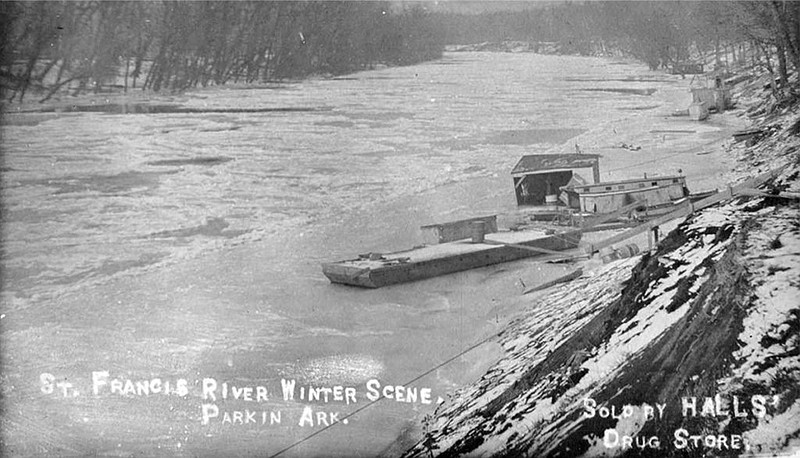The St. Francis River in eastern Arkansas is, for much of its length, a slow and muddy waterway, but this modest river has borne witness to some of the most important developments in Arkansas history.
The St. Francis River originates in the northeastern corner of Iron County, Mo., and flows for 25 miles through the St. Francois Mountains, where it is a clear, fast-flowing whitewater stream until it reaches just north of Poplar Bluff, Mo. At this point the river becomes a sluggish, silt-laden stream typical of those in the Mississippi Delta. The river then turns south and travels 207 miles, forming part of the boundary between the Missouri Bootheel and northeastern Arkansas and then coursing between Crowley's Ridge and the Mississippi River. The mouth of the St. Francis, where it flows into the Mississippi, is in the St. Francis National Forest just north of Helena-West Helena.
The St. Francis River valley has been the site of human habitation since approximately 10,000 BC, as evidenced by the numerous Dalton Period sites that have been excavated in the river basin. However, the most famous American Indian settlement along the river is probably a Mississippian Period village settled between 1000 and 1250 AD. This village site, complete with an Indian mound, entered the historical record when the expedition of Hernando de Soto encountered it in 1541, and what remains is preserved at the Parkin Archeological State Park. Archaeologist Clarence Bloomfield Moore found other Indian mounds along the St. Francis River in St. Francis County.
After de Soto, the next Europeans to visit Arkansas, Father Jacques Marquette and Louis Joliet, explored part of the lower St. Francis River and likely gave the river its name, although it is uncertain which saint served as the namesake — perhaps either St. Francis of Assisi or St. Francois Xavier. From the 1780s to the 1820s, the St. Francis River basin was again the site of Indigenous settlement as the Cherokee moved to the area and established homes.
Part of the St. Francis River in Arkansas, between Lake City and Marked Tree, is known as St. Francis Lake or the "Sunken Lands." Here, the river dropped 6 to 8 feet during the New Madrid Earthquakes of 1811–1812, causing the river to "drown" and form a large, swampy overflow area. The Arkansas Game and Fish Commission now conserves more than 27,000 acres of this overflow area as the St. Francis Sunken Lands Wildlife Management Area.
Certain places along the river were strategically important during the Civil War. The ferry on the St. Francis River at Chalk Bluff in Clay County allowed individuals moving from the Missouri Bootheel into northeastern Arkansas to access the elevated roads on Crowley's Ridge, thus avoiding the swampy roads to the east and west of Crowley's Ridge. Multiple Union expeditions proceeded up the St. Francis River from Helena during the war to disperse Confederates, including one March 5, 1863, expedition led by a future Arkansas governor, Col. Powell Clayton.
The St. Francis River was not navigable in its natural state, having numerous snags and rafts. In 1836 and 1837, W. Bowling Buion surveyed the river under the auspices of the federal government with an eye toward improving navigation, but nothing came of it. Only after the Civil War did the U.S. Congress begin funding the clearing of the river. Because the swampy "Sunken Lands" impeded progress on railroad construction until the land began to be drained in the late 1890s and early 1900s, steamboats continued to operate on the river until well into the early 20th century.
The St. Francis Levee District was created in 1893 and began constructing levees and drainage canals to control flooding. These measures were strengthened and increased after the catastrophic flood of 1927 and the passage of the Flood Control Act of 1928. These measures have greatly affected the natural course of the river and have included a number of diversion ditches that run somewhat parallel to the river along its course from southeastern Craighead County down through Lee County, thus providing an outlet for excess water in time of flood.
The U.S. Army Corps of Engineers installed the world's largest siphons on the St. Francis at Marked Tree in 1939 to help with flood control. The Marked Tree Siphons are listed on the National Register of Historic Places. The corps built the W. G. Huxtable Pumping Plant southeast of Marianna in 1977 to prevent Mississippi River floodwater from moving into the St. Francis. It is considered the world's largest pumping plant of its kind.
— Jodi Morris
This story is adapted by Guy Lancaster from the online Encyclopedia of Arkansas, a project of the Central Arkansas Library System. Visit the site at encyclopediaofarkansas.net.
